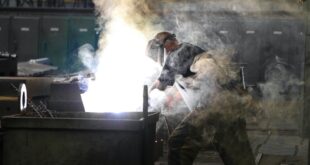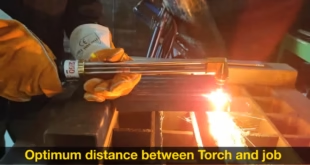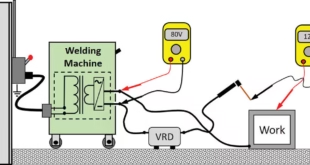Do’s and Don’ts in Welding
Introduction
Welding is a vital process used in many industries, including construction, manufacturing, and automotive repair. It involves the use of heat and pressure to fuse two or more metal parts together, creating a strong, permanent bond.
However, welding can also be a hazardous activity if not done properly. There are various risks associated with welding, including burns, electrical shock, inhalation of toxic fumes, and more. Therefore, it is essential to know the do’s and don’ts of welding to ensure the safety of the welder and anyone in the surrounding area.
Knowing the proper safety precautions and guidelines for welding can help prevent accidents and injuries. The purpose of this outline is to provide an overview of the do’s and don’ts in welding, as well as tips for safe welding practices.
The following sections will cover the do’s and don’ts of welding, common welding hazards and precautions, best practices for welding safety, and a conclusion emphasizing the importance of welding safety.

Do’s in Welding
Use proper protective equipment: It is essential to wear the appropriate protective gear when welding. This includes a welding helmet, safety glasses, welding gloves, flame-resistant clothing, and safety shoes. The protective gear should be in good condition and fit properly to provide adequate protection.
Follow manufacturer’s instructions and welding procedures: Welding equipment and processes vary, and it is crucial to follow the manufacturer’s instructions and recommended welding procedures. This ensures that the welding is done correctly and safely.
Keep the welding area clean and free of clutter: A clean and organized workspace reduces the risk of accidents and injuries. Remove any unnecessary materials and debris from the welding area to prevent tripping hazards and fires.
Check the welding equipment before use: Before using the welding equipment, inspect it to ensure that it is in good working condition. Check the welding cables, connectors, and grounding connections for signs of wear and damage.
Ensure proper ventilation in the workspace: Welding produces toxic fumes and gases that can cause respiratory problems. Therefore, it is important to have proper ventilation in the workspace. This can be achieved by using an exhaust system or working in an area with natural ventilation.
Keep a fire extinguisher nearby: Welding produces high heat and sparks that can ignite nearby flammable materials. Always keep a fire extinguisher nearby in case of a fire emergency.
Don’ts in Welding
Weld on surfaces coated with flammable materials: Welding on surfaces coated with flammable materials can cause fires and explosions. Therefore, it is important to clean the surfaces before welding.
Touch the welding electrode with bare hands: Welding electrodes are highly charged and can cause electrical shock if touched with bare hands. Always use the proper tools, such as pliers, to hold the electrode.
Look directly at the welding arc without proper eye protection: The welding arc produces intense light that can cause eye damage. Always wear proper eye protection, such as welding helmets or goggles, to protect the eyes.
Weld without proper ventilation: Welding produces toxic fumes and gases that can cause respiratory problems. Welding in an area without proper ventilation can be hazardous to the welder and anyone in the surrounding area.
Weld in areas with explosive or flammable gases: Welding in areas with explosive or flammable gases can cause fires and explosions. It is essential to avoid welding in such areas.
Weld on metal surfaces that have been painted or coated with chemicals: Welding on metal surfaces that have been painted or coated with chemicals can release toxic fumes and gases that can be harmful to the welder and anyone in the surrounding area.
Tips for Safe Welding
- Attend welding safety training: Welding safety training is essential to learn the proper safety procedures and precautions for welding. This training should be attended by all welders, and it should be updated periodically to ensure that everyone is up-to-date on the latest safety guidelines.
- Properly ground the welding equipment: Grounding the welding equipment helps prevent electrical shock and other electrical hazards. Always ensure that the equipment is properly grounded before welding.
- Use the correct type of welding rod for the metal being welded: Using the correct type of welding rod for the metal being welded ensures a strong and secure bond. The welding rod should be compatible with the metal being welded, and the manufacturer’s recommendations should be followed.
- Use caution when working with electricity and welding gas: Welding involves working with high voltage electricity and flammable gases. Always use caution when working with these materials, and ensure that all safety precautions are followed.
- Take breaks to prevent fatigue: Welding can be a physically demanding job that requires concentration and attention to detail. Taking breaks can help prevent fatigue and reduce the risk of accidents.
- Seek medical attention if necessary after a welding-related injury: If a welder sustains an injury while welding, they should seek medical attention immediately. Some injuries, such as burns or exposure to toxic fumes, may not be immediately apparent, and prompt medical attention is essential.
Common Welding Hazards and Precautions
Welding involves several hazards that can cause accidents and injuries if not addressed. Some of the common welding hazards include electrical shock, burns, eye injuries, inhalation of toxic fumes, and more. Therefore, it is essential to take precautions to prevent these hazards.
Some of the precautions that can be taken include wearing the appropriate personal protective equipment, such as a welding helmet, gloves, and flame-resistant clothing. Proper ventilation is also necessary to prevent the inhalation of toxic fumes. The welding area should be kept clean and free of clutter to reduce the risk of tripping hazards and fires. The welding equipment should be inspected before use to ensure that it is in good working condition, and a fire extinguisher should be kept nearby in case of an emergency.
Other precautions include proper grounding of the welding equipment, using the correct type of welding rod for the metal being welded, and taking breaks to prevent fatigue. Welding safety training is also essential to learn the proper safety procedures and precautions for welding.
FAQs
What are the do’s and don’ts in welding?
- Do wear appropriate personal protective equipment (PPE), including gloves, safety glasses, welding helmets, and clothing made of flame-resistant materials.
- Do ensure proper ventilation in the workspace to prevent exposure to fumes and gases.
- Do inspect welding equipment and tools regularly for damage or wear and tear.
- Do keep the work area clean and free of debris to avoid tripping hazards.
- Don’t weld in an area where flammable materials are present or near open flames.
- Don’t touch the electrode or welding wire with bare hands, and avoid touching hot metal with skin or clothing.
- Don’t weld without proper training and certification.
What are the 10 safety rules when welding?
10 Safety Rules when Welding:
- Wear appropriate PPE.
- Inspect equipment before use.
- Keep a fire extinguisher nearby.
- Maintain proper ventilation.
- Keep the work area clean and free of tripping hazards.
- Use appropriate welding techniques and settings.
- Use caution when handling hot metal and tools.
- Avoid welding near flammable materials.
- Have a safety plan in place in case of an emergency.
- Obtain proper training and certification before welding.
What is the number 1 rule in welding?
Number 1 Rule in Welding: The number 1 rule in welding is to prioritize safety above all else. This means wearing appropriate PPE, following proper welding techniques and settings, and avoiding hazardous conditions.
What are 3 safety rules for welding?
Safety Rules for Welding:
- Wear appropriate PPE, including gloves, safety glasses, welding helmets, and clothing made of flame-resistant materials.
- Inspect equipment and tools regularly for damage or wear and tear.
- Keep the work area clean and free of debris and tripping hazards.
What are the 11 helpful tips in welding?
Here are 11 Helpful Tips in Welding:
- Use the proper welding technique for the type of metal being welded.
- Choose the appropriate welding process and equipment for the job.
- Use the appropriate filler material for the type of metal being welded.
- Ensure proper alignment of the metal pieces before welding.
- Keep the welding area clean and free of debris.
- Use appropriate ventilation to prevent exposure to fumes and gases.
- Avoid welding near flammable materials.
- Use proper lifting techniques when moving heavy metal pieces.
- Use caution when handling hot metal and tools.
- Obtain proper training and certification before welding.
- Follow all safety guidelines and regulations.
What are the 5 fundamentals of welding?
These are 5 Fundamentals of Welding:
- Understanding the properties of the metal being welded.
- Choosing the appropriate welding process and equipment for the job.
- Properly preparing the metal surfaces for welding.
- Ensuring proper alignment of the metal pieces before welding.
- Using the appropriate filler material and welding technique for the type of metal being welded.
What are the 7 hazards of welding?
The 7 Hazards of Welding are:
- Exposure to fumes and gases.
- Burns from hot metal and tools.
- Eye damage from welding arc radiation.
- Electric shock.
- Fires and explosions.
- Noise exposure.
- Tripping hazards in the workspace.
What are the 5 major safety concerns while welding?
5 Major Safety Concerns while Welding:
- Proper use of PPE to prevent burns, eye damage, and exposure to fumes and gases.
- Proper ventilation to prevent exposure to fumes and gases.
- Proper handling of hot metal and tools to prevent burns.
- Avoiding welding near flammable materials to prevent fires and explosions.
- Ensuring proper training and certification to avoid accidents and injuries.
What is the safety in welding?
Safety in welding involves wearing appropriate PPE, inspecting equipment and tools regularly, maintaining proper ventilation, keeping the workspace clean and free of tripping hazards, using appropriate welding techniques and settings, and avoiding hazardous conditions.
What is PPE in welding?
PPE stands for Personal Protective Equipment. In welding, PPE refers to the equipment and clothing worn by welders to protect themselves from potential hazards during the welding process. PPE includes items such as welding helmets, gloves, safety glasses, respirators, welding jackets, and steel-toed boots. The use of appropriate PPE is crucial for welders to prevent injuries and health problems such as eye injuries, burns, respiratory issues, and exposure to harmful fumes and particles.
Why is PPE important in welding?
PPE (Personal Protective Equipment) is important in welding because it provides a barrier between the welder and potential hazards, such as sparks, heat, radiation, and fumes. These hazards can cause burns, respiratory problems, and other serious injuries if they come into contact with the skin, eyes, or lungs. PPE can include a variety of equipment, such as helmets, gloves, aprons, respirators, and safety glasses or goggles, all of which help to reduce the risk of injury or illness while welding. It is essential for welders to wear appropriate PPE to ensure their safety on the job.
What are the 3 types of welding?
There are several types of welding, but here are the three most common types:
- MIG (Metal Inert Gas) Welding: It is a process that uses a spool of wire which is fed through a gun and joined with the workpiece. A shielding gas is used to protect the weld from contamination.
- TIG (Tungsten Inert Gas) Welding: It uses a non-consumable tungsten electrode to produce the weld. A filler material may or may not be used, depending on the application.
- Stick Welding (Shielded Metal Arc Welding or SMAW): It is a process that uses a consumable electrode and a power supply to create an arc between the electrode and the workpiece. The electrode melts and forms the weld, and a flux coating on the electrode protects the weld from contamination.
Conclusion
In conclusion, welding is an important skill that requires knowledge, practice, and safety precautions. Knowing the dos and don’ts of welding can help ensure a successful and safe welding experience. Some of the important dos include properly preparing the materials, selecting the appropriate welding technique and equipment, and wearing appropriate safety gear. Some of the important don’ts include welding in poorly ventilated areas, neglecting to check for flammable materials nearby, and welding without proper supervision or training. By following these guidelines and practicing good welding habits, individuals can reduce the risk of injury, ensure the quality of their welds, and enjoy a successful welding experience
 Welding of Welders All about Welding and Welders
Welding of Welders All about Welding and Welders



